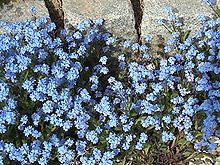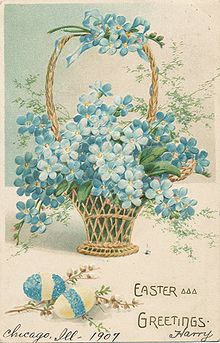- Forget-me-not
-
This article is about the flower. For other uses, see Forget me not (disambiguation).
Forget-me-not 
Scientific classification Kingdom: Plantae (unranked): Angiosperms (unranked): Eudicots (unranked): Asterids Order: (unplaced) Family: Boraginaceae Subfamily: Boraginoideae Genus: Myosotis
L.Species Around 50
Myosotis (
 /ˌmaɪ.əˈsoʊtɪs/;[1] from the Greek: "mouse's ear", after the leaf) is a genus of flowering plants in the family Boraginaceae that are commonly called Forget-me-nots. Its common name was calqued from the French, "ne m'oubliez pas" and first used in English in c. 1532. Similar names and variations are found in many languages.
/ˌmaɪ.əˈsoʊtɪs/;[1] from the Greek: "mouse's ear", after the leaf) is a genus of flowering plants in the family Boraginaceae that are commonly called Forget-me-nots. Its common name was calqued from the French, "ne m'oubliez pas" and first used in English in c. 1532. Similar names and variations are found in many languages.Contents
Description
There are approximately fifty species in the genus, with much variation. Most have small (1 cm diameter or less) flat, 5-lobed blue, pink or white flowers with yellow centers, growing on scorpioid cymes. They bloom in spring. Leaves are alternate. Popular in gardens, Forget-me-nots prefer moist habitats and where they are not native, they have escaped to wetlands and riverbanks. They can tolerate partial sun and shade.
Forget-me-nots may be annual or perennial plants. Their root systems are generally diffuse. Their seeds are found in small, tulip-shaped pods along the stem to the flower. The pods attach to clothing when brushed against and eventually fall off, leaving the small seed within the pod to germinate elsewhere. Seeds can be collected by putting a piece of paper under the stems and shaking them. The seed pods and some seeds will fall out.
They are widely distributed. Many Myosotis species are endemic to New Zealand, though it is likely that the genus originated in the Northern Hemisphere [2]. One or two European species, especially the Wood Forget-me-not, Myosotis sylvatica have been introduced into most of the temperate regions of Europe, Asia and America. Myosotis scorpioides is also known as scorpion grass due to the spiraling curve of its inflorescence. Myosotis alpestris is the state flower of Alaska.
Forget-me-nots are used as food plants by the larvae of some Lepidoptera species including Setaceous Hebrew Character.
Other plants called forget-me-not
The Chatham Islands forget-me-not belongs to a related genus, Myosotidium
Folklore and legend
 Myosotis sylvatica (Wood Forget-me-not)
Myosotis sylvatica (Wood Forget-me-not)
In a German legend, God named all the plants when a tiny unnamed one cried out, "Forget-me-not, O Lord!" God replied, "That shall be your name."[3]
Henry IV adopted the flower as his symbol during his exile in 1398, and retained the symbol upon his return to England the following year.[3]
In 15th-century Germany, it was supposed that the wearers of the flower would not be forgotten by their lovers. Legend has it that in medieval times, a knight and his lady were walking along the side of a river. He picked a posy of flowers, but because of the weight of his armour he fell into the river. As he was drowning he threw the posy to his loved one and shouted "Forget-me-not." It was often worn by ladies as a sign of faithfulness and enduring love.
Remembrance
Prior to becoming the tenth province of Canada in 1949, Newfoundland (then a separate British Dominion) used the Forget-me-not as a symbol of remembrance of that nation's war dead. This practice is still in limited use today, though Newfoundlanders have adopted the Flanders Poppy as well.
Freemasons began using the flower in 1926 as a symbol well known in Germany as message not to forget the poor and desperate. Many other German charities were also using it at this time. In later years, by a handful of Masons, it was a means of recognition in place of the square and compass design. This was done across Nazi occupied Europe to avoid any danger of being singled out and persecuted. The symbol of the forget-me-not in modern Masonry has become more prevalent and exaggerated claims about the use of the symbol are often made in order to promote sales of bumper stickers of the symbol. [4] Today it is an interchangeable symbol with Freemasonry and some also use the Forget-me-not to remember those masons who were victimized by the Nazi regime.[5]
In literature
Henry David Thoreau wrote, "The mouse-ear forget-me-not, Myosotis laxa, has now extended its racemes very much, and hangs over the edge of the brook. It is one of the most interesting minute flowers. It is the more beautiful for being small and unpretending; even flowers must be modest."[6]
In Evangeline, Henry Wadsworth Longfellow wrote,
- Silently, one by one, in the infinite meadows of Heaven,
- Blossom the lovely stars, the forget-me-nots of the angels.
In his 1947 long poem "Notes Toward a Supreme Fiction," Wallace Stevens mentions the forget-me-not, using its scientific Greek-derived name:
- ...It observes the effortless weather turning blue
- And sees the myosotis on its bush."
Keith Douglas, 1920–1944, wrote his poem "Vergissmeinnicht" (Forget-me-not) about a dead German soldier in World War II whose body is found by the poet with a photograph of his girl with her words written "Steffi. Vergissmeinnicht" but it's not believed by some people.[citation needed]
J.R.R. Tolkien refers to the flower in his poems. The character of Tom Bombadil is said to have the colour of the flower on his jacket (Lord of the Rings, chapter seven, book I).
In Harry Potter and the Chamber of Secrets by J.K Rowling when Harry Potter first meets Professor Lockhart, Professor Lockhart "...was wearing robes of forget-me-not blue that exactly matched his eyes..." (chapter four page 59 of the 1999 American edition).
Selected species
- Myosotis alpestris - Alpine Forget-me-not
- Myosotis arvensis - Field Forget-me-not
- Myosotis asiatica - Asiatic Forget-me-not
- Myosotis azorica - Azores Forget-me-not
- Myosotis caespitosa - Tufted Forget-me-not
- Myosotis decumbens
- Myosotis discolor - Changing Forget-me-not
- Myosotis latifolia - Broadleaf Forget-me-not
- Myosotis laxa - Tufted Forget-me-not, Bay Forget-me-not
- Myosotis maritima - Maritime Forget-me-not, endemic to the archipelago of the Azores[7]
- Myosotis nemorosa
- Myosotis ramosissima
- Myosotis scorpioides - True Forget-me-not
- Myosotis secunda - Creeping Forget-me-not
- Myosotis sicula - Jersey Forget-me-not
- Myosotis stricta
- Myosotis sylvatica - Wood Forget-me-not
- Myosotis verna - Spring Forget-me-not
- Myosotis venosa
- Myosotis forsteri
Gallery
-
Artist S.L.Kozhin Picture painted Opalikha in Krasnogorsk, Russia Myosotis verna. 2009.
References
- ^ "Myosotis". Oxford English Dictionary. Oxford University Press. 2nd ed. 1989.
- ^ The origins and evolution of the genus Myosotis [1]
- ^ a b Sanders, Jack. The Secrets of Wildflowers: A Delightful Feast of Little-Known Facts, Folklore, and History. Globe Pequot, 2003. ISBN 1585746681. ISBN 978-1585746682.
- ^ "Das Vergissmeinnicht". http://detroitno2.com/v2/freemasonry/das-vergissmeinnicht/. Retrieved 4 July 2011.
- ^ Virtual-loi.co.uk
- ^ Thoreau, Henry David; Blake, Harrison Gray Otis; Emerson, Ralph Waldo; Sanborn, Franklin Benjamin (1884), The Writings of Henry David Thoreau (vol 6), p. 109, http://books.google.com/?id=_14dAAAAIAAJ
- ^ Secretaria Regional do Ambiente e do Mar (2008), Plantas Endémicas dos Açores: Guia da Ilha do Faial, p.8; Flowering between April and June, the maritima is herbaceous from drought coastal zone, but below 150 meters altitudes.
Categories:- Myosotis
- Flowers
- Garden plants
Wikimedia Foundation. 2010.













